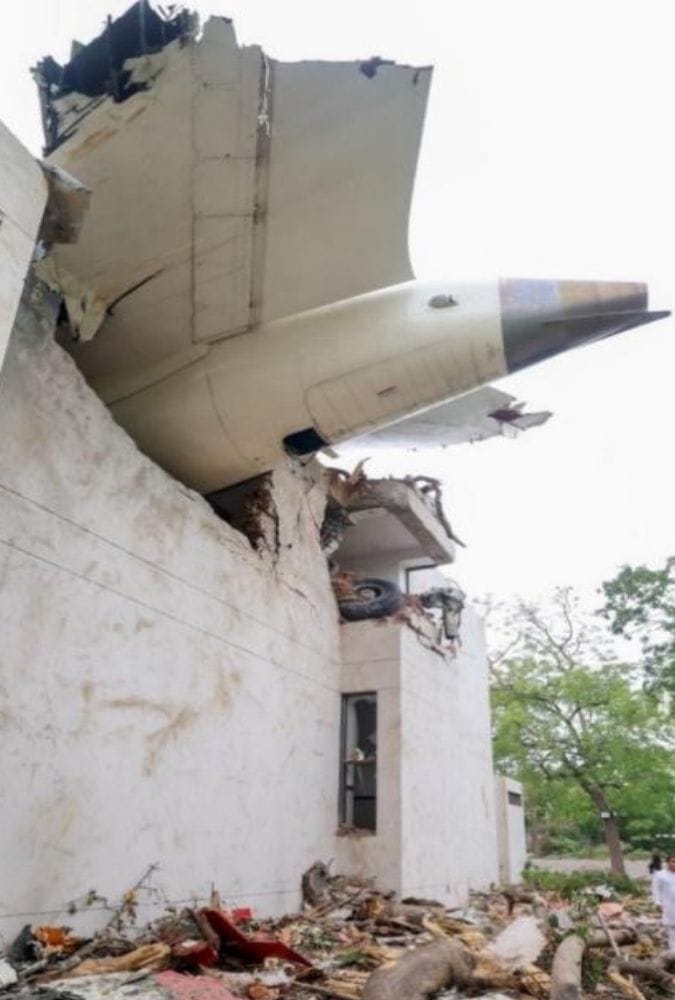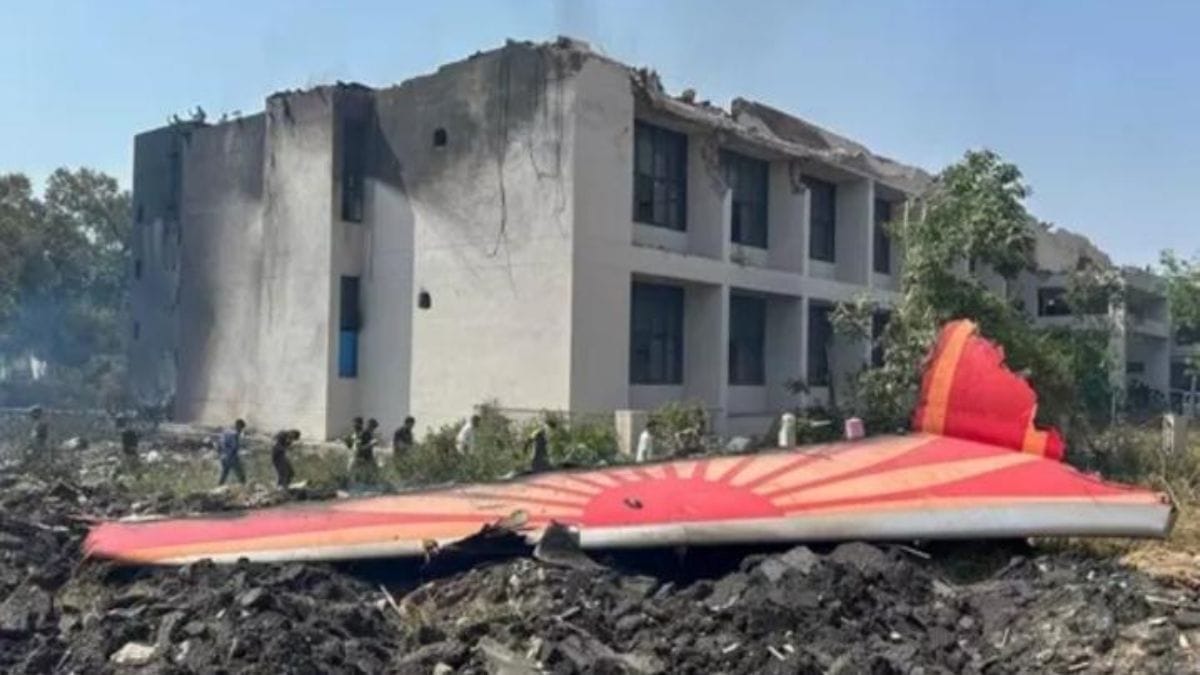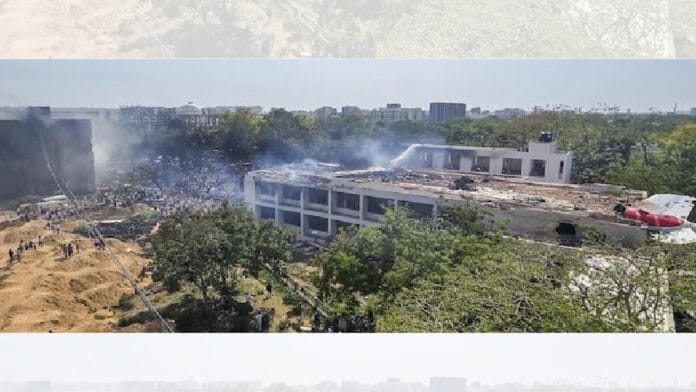New Delhi: The Aircraft Accident Investigation Bureau (AAIB) has released a preliminary report of the initial investigation into the 12 June crash of Air India Flight AI 171 in Ahmedabad, Gujarat.
AI 171, scheduled to fly from Ahmedabad to London Gatwick, tragically crashed soon after take-off, resulting in the loss of 275 lives. This includes all 241 individuals aboard—229 passengers and 12 crew members—and people on the ground. The sole survivor was passenger Vishwashkumar Ramesh, who managed to escape through the emergency exit.
The report reveals what happened in the run-up to the aircraft take-off and the crucial 32 seconds after its take-off.
Before take-off
11:17:00 IST The aircraft concerned—a Boeing 787-8, VT-ANB—touched down at Sardar Vallabhbhai Patel International Airport and was parked at Bay 34.
11:55:00 The crew of flight AI 171 arrived at the airport, and breath analyser tests found all of them fit to fly.
12:10:00 The aircraft was released for flight after Air India’s on-duty Aircraft Maintenance Engineer carried out troubleshooting, according to the Flight Information Manual.

The crew of the previous flight, AI423, using the aircraft, had made a ‘pilot defect report’ entry related to a stabiliser sensor—status message “STAB POS XDCR”—in the tech log.
12:35:00 The boarding gate CCTV recording showed the AI171 crew arriving for duty. The flight crew included a pilot-in-command holding an airline transport pilot licence, a co-pilot holding a commercial pilot licence, and 10 cabin crew.
13:10:00 The scheduled start time for AI171-related operations. The co-pilot was supposed to fly, and the senior pilot was to monitor the flight. They arrived in Ahmedabad from Mumbai on 11 June and had adequate rest.
13:13:00 AI171—a Boeing 787-8, VT-ANB—requested pushback and startup. There were 230 passengers on board. Fuel on board was 54,200 kg, and the take-off weight was 2,13,401 kg—within the limit allowed. There were no ‘dangerous goods’ on board the aircraft.
13:13:13 Air Traffic Control (ATC) approved pushback.
13:16:59 ATC approved engine startup clearance.
13:18:38 ATC queried if the aircraft required the full length of the runway, and the aircraft confirmed the requirement of the full length of Runway 23. The aircraft was observed departing from Bay 34.
13:25:15 The aircraft requested taxi clearance, and the ATC granted it.
13:26:08 Aircraft taxied from the bay towards Runway 23 via Taxiway R4.
13:32:03 The aircraft control was transferred from ‘Ground‘ to ‘Tower’.
13:33:45 Aircraft was instructed to line up on Runway 23.
13:37:33 Aircraft was cleared for take-off from Runway 23. The wind was coming from 240 degrees (west-southwest) at a speed of six knots.
13:37:37 AI171 started rolling.

13:38:33 The aircraft crossed the take-off decision speed (V1)—the point beyond which take-off must continue even if an issue arises—and subsequently achieved 153 knots indicated airspeed (IAS), indicating a commitment to take-off and sufficient speed for liftoff or rotation, according to the enhanced airborne flight recorder (EAFR).
13:38:35 The aircraft reached the Vr speed of 155 knots—the rotation speed at which the pilot begins to gently lift the nose wheel off the runway, initiating the aircraft’s take-off and transition to flight.
13:38:39 The aircraft air/ground sensors transitioned to air mode, consistent with liftoff. Everything was normal up to this point.
After take-off

13:38:42 IST The aircraft reached its maximum recorded airspeed of 180 knots indicated airspeed, representing the highest speed measured by the aircraft’s instruments.
Immediately after, the fuel switches for Engine 1 and Engine 2 were turned off one after the other, just one second apart. As the engines stopped getting fuel, their speeds began dropping from the take-off levels. According to the cockpit audio, one pilot asked the other why he turned the fuel off, and the other pilot replied that he didn’t do it.
The airport’s CCTV footage showed the Ram Air Turbine (RAT) deployed right after the plane took off during its initial climb. At the time, there were no signs of birds near the flight path. The aircraft began to lose height before it even passed the airport’s perimeter fence.
13:38:47 Both engines slowed down below the lowest speed required to run properly, so the small emergency turbine called the Ram Air Turbine (RAT) started working to supply hydraulic power and keep important systems functioning, according to the EAFR.
13:38:52 The fuel switch for Engine 1 was turned back on from the off position (cutoff) to the on position (run), meaning fuel started flowing to the engine again, according to the EAFR.
13:38:54 The Auxiliary Power Unit (APU) inlet door started to open automatically, i.e., the system was getting ready to start the APU on its own.
13:38:56 The fuel switch for Engine 2 was turned back on from off (cutoff) to on (run). When this happens during flight, the engine’s automatic control system—FADEC (Full Authority Digital Engine Control)—takes over to restart the engine and bring its power back by managing the fuel and ignition.

The temperature at the back of both engines—EGT (Exhaust Gas Temperature)—went up, indicating that the engines were trying to restart. Engine 1 stopped slowing down and started getting back to normal speed. Engine 2 managed to restart but kept slowing down, so the system kept adding fuel again and again to try to speed it up and recover properly.
13:39:11 The EAFR recording stopped.
Crash
13:39:05 IST One of the pilots transmitted “Mayday Mayday Mayday”. The air traffic control officer (ATCO) enquired about the call sign. The ATCO did not get any response but observed the aircraft crashing outside the airport boundary and activated the emergency response.
13:44:44 Crash fire tender left the airport premises for rescue and firefighting, with the fire and rescue services of the local administration joining them.
(Edited by Madhurita Goswami)
Also Read: Why do airplanes still crash?






